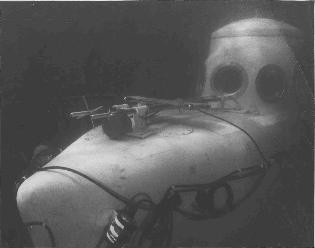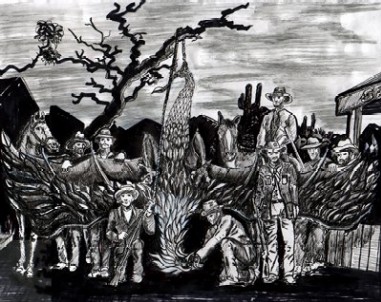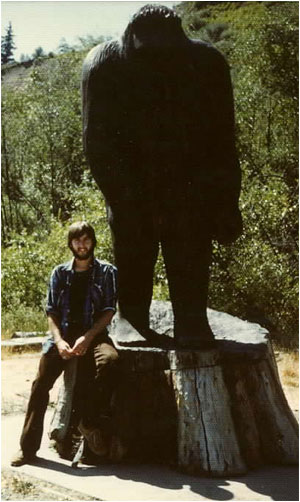Post-Discovery: Still Bigfoot? Nessie? Chupacabras? Thunderbird?
Posted by: Loren Coleman on December 1st, 2006

There is nothing wrong with your computer. Do not attempt to adjust your screen. We are controlling transmission. We can reduce the focus to a soft blur, or sharpen it to crystal clarity (actually, we can’t and the cartoon above is out of focus, on purpose). For the next few minutes, sit quietly and we will control all that you read. You are about to experience the awe and mystery which reaches from the inner mind to… Cryptomundo.
Well, sometimes it might seem that way, but this blog is an example of how people can read words, names, monikers, and terms, and walk away with a totally different sense of reality from that which we might be trying to share. That’s okay. Perhaps this creates possibilities in all our tomorrows for more comprehensive discourses.
Scott Maruna, the managing editor of The Anomalist newsline, has written a blog today, entitled "The Cryptosemantics of Cryptozoology" .
Scott begins by saying:
One hang-up and contention I have with the study of cryptozoology: semantics. I will present my case here and honestly hope that someone out there can guide, help or even correct me if I am wrong. However, so long as I have been involved in this field, the semantics of it has always seemd to be a glaring weak spot, one that needs cleaned up.
Read his blog for the scenarios and situations he gives – on Bigfoot, Chupacabras, Nessie, and Thunderbirds. Maruna asks questions that haunt the line between the undiscovered and the discovery, for example:
“Is that a Bigfoot or not?”
"Chupacabra[s]…What is it? How is it that we will know when one is found?"
"A biologist discovers an eel species within the loch that, in certain situations and conditions, grows to colossal proportions. Would this be announced as the long-awaited discovery of the enigmatic Loch Ness Monster?"
"My research has shown that that gigantic Washington eagle did exist and quite possibly still does exist. Does that make it a Thunderbird?"
My response is below:
^^^^^^^^^^^^^^
I have usually found the major source of misunderstanding the words and terms linked to cryptozoology is by internalizing the more popular or media-driven sense of what the field is all about. For those that wish to take some time to reach a little deeper, as Scott is demonstrating here, there are clearer answers.
Cryptids, as I have written about often, are unknown until they are identified. Look, if a cryptid is positively found to be a mistake, a hoax, a known species, it will be said to be that. If it is an unknown species, newly confirmed and discovered, it will be congratulated, probably, as a success story of cryptozoology. But, of course, once that species is assuredly identified as "new," it will also join the ranks of zoology and/or anthropology. The same goes for a "re-discovered" species, such as the Laotian rock rat or the Ivory-billed woodpecker.
I highly recommend people interested read the fuller definitions click on my blog on cryptoterms, here:

Therefore, allow me to attempt to very directly answer the above blog’s diverse and dissimilar scenarios. Here’s how a middle-of-the-road cryptozoologist, like me, might see this unfolding:
If Bigfoot is a new species or an extinct species confirmed alive, it’s Latin name and popular name will be retained or newly created to reflect it being a bigfoot or sasquatch or something similar. But if Bigfoot is confirmed, for example, as a tribe of hairy Indians (Homo sapiens), they will no longer be called "Bigfoot," no doubt. They would be seen as merely a very strange (with no value judgments) variety of humans, but still Homo sapiens sapiens.

Now Chupacabras is another, radically different situation. Chupacabras (yes, it is a Spanish word that is spelled like an English plural, but that form is both singular and plural) has become an umbrella term. The Latin cryptid name is much like the regional name "Jersey Devil" and they both attempt to cover all kinds of weird and unfamiliar animal and creature reports based on a location focus, not a zoological focus.
Reporters in the American Southwest incorrectly use Chupacabras all the time to talk about canid (all kinds of doglike animals with mange and health problems) photos that come into their newsrooms. These "Chupacabras" have little to do with the cryptid Chupacabras from Puerto Rico, first reported extensively in the 1970s, which are bipedal, hairy, with spiked hair, that killed goats. The SW’s misnamed Chupacabras are frequently identified as "diseased foxes," "sick dogs," or "mangy coyotes" because that is what they are. But they have nothing to do with the initial Chupacabras, therefore the Chupacabras continue to remain part of cryptozoology.

Now on to the Nessie situation. Scott writes a "wholly hypothetical situation: a biologist discovers an eel species within the loch that, in certain situations and conditions, grows to colossal proportions. Would this be announced as the long-awaited discovery of the enigmatic Loch Ness Monster? I doubt it."
But I think it would.
The key here may be whether or not this is a "wholly" new eel species, or a "wholly" unknown subspecies just occurring in Loch Ness. Yes, of course, it would be the Loch Ness Monster if this discovery occurred, and was found as the source of the reports. (But cryptozoologists might have questions about how a giant eel produced sightings of LNMs with eyelashes, hair on their bodies, and a mane. Or were these eels responsible for the sightings of the large walrus-like animals seen crossing the roads?)
Hardly anyone that is a Loch Ness investigator considers the plesiosaur-in-a-cage scenario one that is going to happen, especially since the most common sightings have an overturned boat appearance, with mammalian characteristics.
But yes, if it was a *new* species of giant eel, then, of course, this would have to be labeled the Loch Ness Monster. Then the zoologists would rush in, pushing aside the cryptozoologists.

The Thunderbird question seems simple enough. If it is proven, beyond a shadow of doubt, that nothing exists, end of the story. If the Thunderbird sightings are definitely linked to a new, unknown, or formerly extinct species, that’s your Thunderbird. If you try to explain Thunderbird sightings by saying they are, for example, turkey vultures, cranes, and ravens, the mystery of this cryptid continues, as those choices do not explain all the reports and the mystery remains.
An open-minded cryptozoologist would not care if the Thunderbird turns out to be a teratorn or a Washington eagle, if they were caught. But cryptozoologists will keep the Thunderbird file active until then, despite debunkers, or despite people who think they are looking for some kind of "formula Thunderbird."
Those that continue to rema
in confused about cryptozoology and its terms by ignoring the realities and recent history of successes (hey, look up the last decade of cryptid names linked to new animals found in SE Asia and Indonesia) are merely setting up strawmen to knock over. That’s of no concern to cryptozoologists who go forward gathering reports of lesser cryptids that turn into new animals or folklore of little people that are linked to new fossil finds from Flores.
I have never experienced cryptosemantics being a barrier in the field. Sometimes I do discover a few cryptoreaders, who are closer to the truth than even they may know, getting frustrated by trying so hard to understand the multi-levels in the differences between the collecting, the labeling, the finding, and the future.

About Loren Coleman
Loren Coleman is one of the world’s leading cryptozoologists, some say “the” leading living cryptozoologist. Certainly, he is acknowledged as the current living American researcher and writer who has most popularized cryptozoology in the late 20th and early 21st centuries.
Starting his fieldwork and investigations in 1960, after traveling and trekking extensively in pursuit of cryptozoological mysteries, Coleman began writing to share his experiences in 1969. An honorary member of Ivan T. Sanderson’s Society for the Investigation of the Unexplained in the 1970s, Coleman has been bestowed with similar honorary memberships of the North Idaho College Cryptozoology Club in 1983, and in subsequent years, that of the British Columbia Scientific Cryptozoology Club, CryptoSafari International, and other international organizations. He was also a Life Member and Benefactor of the International Society of Cryptozoology (now-defunct).
Loren Coleman’s daily blog, as a member of the Cryptomundo Team, served as an ongoing avenue of communication for the ever-growing body of cryptozoo news from 2005 through 2013. He returned as an infrequent contributor beginning Halloween week of 2015.
Coleman is the founder in 2003, and current director of the International Cryptozoology Museum in Portland, Maine.










Re: Loch Ness – Some of the land sightings clearly describe legs, I don’t think an eel covers that. Plus the sightings describing a long, flexible neck would be nearly impossible for an eel to do physiologically. If they hauled up a huge eel tomorrow it would be a great breakthrough, but it wouldn’t answer all the evidence.
Re: Thunderbirds – I think the Washington Eagle existed and likely does exist too. But it is very different from a lot of Thunderbird sightings. Especially the beak – Thunderbirds are alleged to have longer beaks like a raven or vulture rather than a beak like an eagle. They’re also frequently described as having a white ring around their neck and white markings on the wings, which don’t fit the paintings and descriptions of the Washington Eagle. Not to pick nits, but I think at least two distinct species are being described.
Yes. Most of the suggested species (existing ones and those exticnt) we have for crytids do not answer all the evidence/sightings…
hey loren, awesome new article about bigfoot nessie & chuprcabra. great artworks as well.
Reading your response to Scott here has crystallised a point I was trying to make in your ‘John Keel – Demonologist?’ piece, but which I couldn’t quite put my finger on then, namely that many people, including, apparently, yourself, take cryptids as all just being pretty normal straightforward animals that are only ununusal because they haven’t quite been proven to exist yet, making them by definition, unfamiliar, and therefore strange; and this in fact may be just exactly the case; and yet if they are, how come every year, just as you say, people are discovering and proving the existence of new species like the lesser-spotted banjoplucker bird of Upper Alabama, or the purple striped jamjar juggling wumbleblatt of Lower Washington, (if such places really exist!), and yet of the ones everyone really wants, like Bigfoot, and have their eyes and cameras on the lookout for 24 hours a day, every day, the best piece of film we still have is the Patterson movie of ’67?
What my suspicion is, is the reason why the likes of Bigfoot continue to prove so elusive, and continue to be associated by many people inside and outside the cryptozoo fold with the likes of UFOs, ghosts, and the Supernatural in general is because not only do these creatures have unnatural intelligence for ‘mere’ animals but they utilize physical laws which we are only just dimly beginning to suspect the existence of. Take the Dolphin, it whizzes through water at terrific speeds, leaps in the air to amazing heights, and yet it only has something like one-sixth of the muscle mass it needs to achieve these feats, something which has still to be explained; nor am I suggesting that this means, then, dolphins are really magical space pixies from planet Cornflake 9. What it might mean though is that critters like the Dolphin and, yes, Bigfoot, may be able to exploit in some way the glitches and anomalies the likes of Quantum Theory (and practise) are increasingly detecting and pointing to in the so-called ‘Laws’ associated with Newtonian Physics, and that is why they are so hard to entrap, either in person or on film; that is why many believers tar them with the Supernatural brush; and, maybe, just maybe, that is one of the reasons why many people spend a great deal of time trying to discredit people like yourself, or poo-poohing a subject concerned with creatures which they profess to have absolutely no belief in – because those creatures, unlike the fabled banjoplucker and the legendary wumbleblatt, scare the living crap out of them!
I think we’re running into 2 separate problems here- The first is how do you know that what you caught is what you think it is? And the second is a problem with language in general.
Here’s my take on it all- If a gigantic, unknown species of Eel were discovered in Loch Ness that could account for even some of the sightings, scientists are going to declare it the Loch Ness Monster, name it accordingly, and consider the matter settled. Some cryptozoologists will agree, others won’t, for precisely the same reasons as someone has already mentioned in this thread. For those who consider it to still be a cryptid, new terms will have to be created to differentiate “their” monster from “the” monster.
Similarly, if Bigfoot is finally recognized by science, which “Bigfoot” will it be (True Giant, Marked Hominid, Skunk Ape, etc.), and what will we call the others if they continue to be reported? You know that if anything even remotely similar to a Bigfoot is discovered and publically acknowledged, that’s what it will be called, unless the discoverer opts for the Yeti or Abominable Snowman moniker, or perhaps is Australian. Lord help us if they call it a Yarwen or something! Whatever they call it, likely it will stick.
Language is like water, it flows into whatever empty spaces gravity allows it to. Like water, any word can be reshaped to fit whatever pigeon hole it’s poured into. Before the CZ community will have had time to deliberate on what was discovered, popular culture will already have named it, copyrighted it, and slapped it on a T-shirt. Anyone remember the Maine Mutant or the Yardley Yeti?
Alanborky, I think any cryptozoologist should be open to even the most outre possibilities, BUT, they must also be very much aware of the probabilities as well. The vast majority of known animals do not appear to have such paranormal characteristics, therefore, it is most likely that any unknown animal will share this characteristic. This may sound dismissive, but in practice it is hard to refute.
To put it in a different context, when a ghost hunter finds an image on his camera, it would be wise to consider all the various and, let’s face it, more probable explanations (Like reflections, odd but conventional light sources, real people, or photographic artifacts, etc.) before they wave their hands in the air and declare it to be their long-dead uncle Fred.
I have spoken here on Cryptomundo many times about the possibility of some cryptid reports being examples of Tulpoids and archetypes of the collective unconscious, which at times can seem to be the only way to account for all the reports we have, so please don’t think I’m criticizing the ideas themselves. There are days when I’m in the Goblin Universe camp where most anything goes, and others when I have my biological blinders on, discounting the more bizarre angles. Like most of us here, I think, on all the rest of the days of the year, I wander about somewhere in between the two, hoping to bump into something unexpected.
I think there’s a chance that if one of the major cryptids is discovered and officially documented there could be an overall expansion in the general public’s idea of what is possible. It would probably be a function of how out of the current mainstream it was – in other words a large eel species in Loch Ness might not expand the public’s mind but a large species of North American hominid/primate might.
There may be more than one answer to the Loch Ness question. That goes for any crypid. Loren, this was a great thought provoking article and the reason we keep coming back to Cryptomundo.